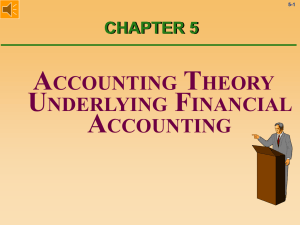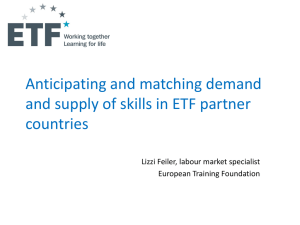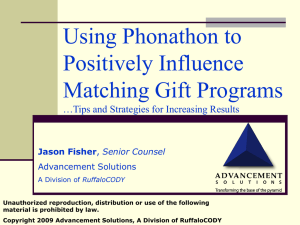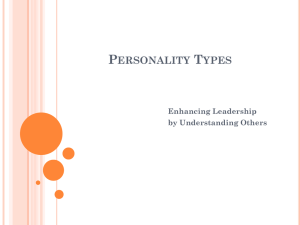Matching Markets
advertisement
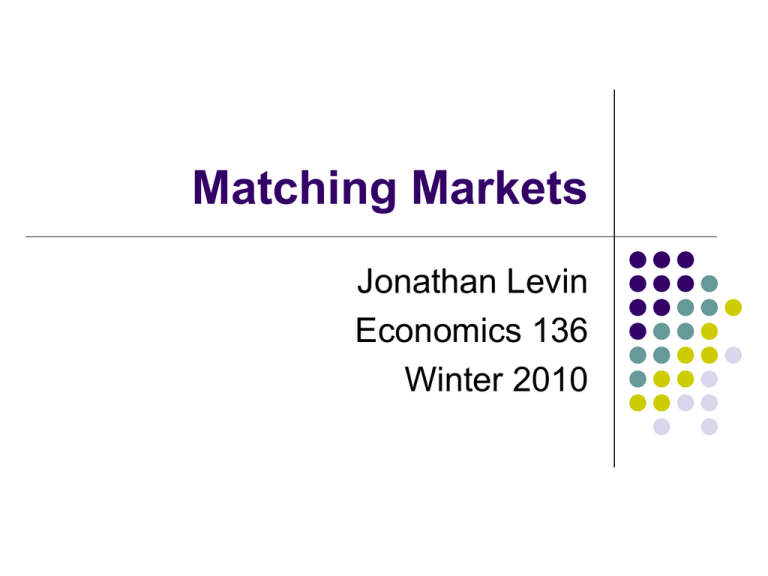
Matching Markets
Jonathan Levin
Economics 136
Winter 2010
National Residency Match
Doctors in U.S. and other countries work as hospital
“residents” after graduating from medical school.
In the US, about 15,000 US med students and many foreigntrained doctors seek residencies each year.
About 4000 hospitals try to fill 20,000+ positions.
Market operates as a central clearinghouse
Students apply and interview at hospitals in the fall.
In February, students and hospitals state their preferences
Each student submits rank-order list of hospitals
Each hospital submits rank-order list of students
Computer algorithm generates an assignment.
Why run a market this way? Does it make sense?
History of NRMP
It wasn’t always this way.
Historically, medical students found residencies through a
completely decentralized process.
But there were problems: students and hospitals made contracts
earlier and earlier, eventually in second year of med school!
Hospitals decided to change the system by adopting a
centralized clearinghouse.
National Residency Matching Program (NRMP) adopted, after
various adjustments in 1952.
System has persisted, though with some modification in late
1990s to handle couples and some recent debate about salaries.
In the early 1980s, it was realized that the NRMP was using an
algorithm proposed by David Gale and Lloyd Shapley in 1962.
Properties they discovered may help explain NRMP success.
School Choice
Most US cities have historically assigned children to
neighborhood schools.
Recently, many cities have adopted school choice programs, that
try to account for the preferences of children and their parents.
School authorities hope choice will lead to more efficient
placements without sacrificing fairness or creating confusion.
Problem seems similar to residency assignment
The most commonly used mechanism, however, is quite
different, and arguably has less desirable properties.
Maybe cities should redesign their programs? In fact, NYC
recently adopted Gale-Shapley algorithm.
As it turns out, school choice is not exactly the same as the
residency problem, and maybe improvements are still possible…
Kidney Exchanges
More than 75,000 people in the United States are waiting to
receive a kidney transplant.
There is a shortage of donors
Deceased donors (maybe 10,000 a year)
Living donors (maybe 7000 a year).
In 2005, 4200 patients died on the wait list.
Problem is not just straight supply and demand
Donor kidney needs to be compatible with the patient.
So sometimes patient has a living donor, but can’t use the kidney
because of incompatibility.
Maybe two patients could trade donor kidneys, or several
patients could engage in a kidney exchange.
It turns out that matching theory can also help us understand this
problem, and make optimal use of a limited pool of donors.
Matching applications galore!
What are the common features of these problems?
Two sides of the market to be matched.
Participants on at least one side, and sometimes on both sides
care about to whom they are matched.
For whatever reason, money cannot be used to determine the
assignment. (Why not?)
Other examples
Housing assignment
College admissions
Fraternity/sorority rush
Judicial clerkships
MBA course allocation
Military postings
Dating websites
NCAA football bowls
Matching Theory
Marriage Model
Participants
Set of men M, with typical man mM
Set of women W, with typical woman w W.
One-to-one matching: each man can be matched to one
woman, and vice-versa.
Preferences
Each man has strict preferences over women, and vice
versa.
A woman w is acceptable to m if m prefers w to being
unmatched.
Matching
A matching is a set of pairs (m,w) such that each
individual has one partner.
If the match includes (m,m) then m is unmatched.
A matching is stable if
Every individual is matched with an acceptable partner.
There is no man-woman pair, each of whom would prefer
to match with each other rather than their assigned partner.
If such a pair exists, they are a blocking pair and
the match is unstable.
Examples
Two men m,m’ and two women w,w’
Example 1
m prefers w to w’ and m’ prefers w’ to w
w prefers m to m’ and w’ prefers m’ to m
Unique stable match: (m,w) and (m’,w’)
Example 2
m prefers w to w’ and m’ prefers w’ to w
w prefers m’ to m and w’ prefers m to m’
Two stable matches {(m,w),(m’,w’)} and {(m,w’),(m’,w)}
First match is better for the men, second for the women.
Is there always a stable match?
Deferred Acceptance Algorithm
Men and women rank all potential partners
Algorithm
Each man proposes to highest woman on his list
Women make a “tentative match” based on their preferred
offer, and reject other offers, or all if none are acceptable.
Each rejected man removes woman from his list, and
makes a new offer.
Continue until no more rejections or offers, at which point
implement tentative matches.
This is the “man-proposing” version of the algorithm;
there is also a “woman proposing” version.
DA in pictures
Stable matchings exist
Theorem. The outcome of the DA algorithm is a stable
one-to-one matching (so a stable match exists).
Proof.
Algorithm must end in a finite number of rounds.
Suppose m, w are matched, but m prefers w’.
At some point, m proposed to w’ and was rejected.
At that point, w’ preferred her tentative match to m.
As algorithm goes forward, w’ can only do better.
So w’ prefers her final match to m.
Therefore, there are NO BLOCKING PAIRS.
Aside: the roommate problem
Suppose a group of students are to be matched to
roommates, two in each room.
Example with four students
A prefers B>C>D
B prefers C>A>D
C prefers A>B>D
No stable match exists: whoever is paired with D wants to
change and can find a willing partner.
So stability in matching markets is not a given, even
if each match involves just two people.
Why stability?
Stability seems to explain at least in part why some
mechanisms have stayed in use.
If a market results in stable outcomes, there is no incentive
for re-contracting.
Roth (1984) argues that stability of NRMP (which uses
Gale-Shapley) helps explain why it has “stuck” as an
institution.
When we look at related markets, many though not all
unstable matching mechanisms have failed.
What would be an alternative?
Decentralized market
What if there is no clearinghouse?
Men make offers to women
Women consider their offers, perhaps some accept and
some reject.
Men make further offers, etc..
What kind of problems can arise?
Maybe w holds m’s offer for a long time, and then rejects it,
but only after market has cleared.
Maybe m makes exploding offer to w and she has to
decide before knowing her other options.
In general, no guarantee the market will be orderly…
Priority matching
Under priority matching, men and women submit preferences,
Each man-woman pair is given a priority based on their mutual
rankings.
The algorithm matches all priority 1 couples and takes them out
of the market.
New priorities are assigned and process iterates.
Example:
Assign priority based on product of the two rankings, so that
priority order is 1-1, 2-1, 1-2, 1-3, 3-1, 4-1, 2-2, 1-4, 5-1, etc…
Algorithm implements all “top-top” matches, then conditional toptops, etc. When none remain, look for 2-1 matches, etc.
Will this lead to a stable matching?
Failure of priority matching
Roth (1991, AER) studied residency matches in
Britain, which are local and have used different
types of algorithms --- a “natural experiment”.
Newcastle introduced priority matching in 1967.
By 1981, 80% of the preferences submitted contained only
a single first choice.
The participants had pre-contracted in advance!
This is the type of “market unraveling” that plagued
the US residency market prior to the NRMP.
We’ll have more to say about unraveling later.
Success of stable mechanisms
Market
Stable?
Still Used?
NRMP
yes
yes
US Medical Specialties (about 30)
yes
yes*
Edinburgh
yes
yes
Cardiff
yes
yes
Birmingham
no
no
Newcastle
no
no
Sheffield
no
no
Cambridge
no
yes
London hospital
no
yes
Canadian lawyers
yes
yes*
Pharmacists
yes
yes
Reform rabbis
yes
yes
Clinical psychologists
yes
yes
UK Residency matches (Roth, 1991)
Optimal stable matchings
A stable matching is man-optimal if every man prefers
his partner to any partner he could possibly have in a
stable matching.
Theorem. The man-proposing DA algorithm results in a
man-optimal stable matching.
This matching is also woman-pessimal (each woman
gets worst outcome in any stable matching).
Note: the same result holds for woman-proposing GS
with everything flipped.
Proof
Say that w is possible for m if (m,w) in some stable matching.
Proof: show by induction that no man is ever rejected by a
woman who is possible for him.
Suppose this is the case through round n.
Suppose at round n+1, woman w rejects m in favor of m’.
Can there be a stable match that includes (w,m)?
If so, m’ must be matched with some w’ who he prefers to w and who
is possible for him (or else w,m’ block).
But then m’ could not be making an offer to w in round n+1: m’ would
have first extended an offer to w’ and would not have been turned
away.
So in no round is a man rejected by a possible woman.
Rural Hospital Theorem
Some years ago, there were a set of hospitals,
mostly in rural areas, that had trouble filling their
positions and were not happy.
Question: would changing around the algorithm help
these hospitals?
Theorem. The set of men and women who are
unmatched is the same in all stable matchings.
Proof of RH Theorem
Consider the man-optimal stable matching and
some other stable matching.
Any man who is matched in the other matching,
must be matched in the man-optimal matching, so at
least as many men are matched in the man-optimal.
Any woman matched in the man-optimal matching
must be matched in all other stable matchings.
In any stable matching, the number of matched men
just equals the number of matched women.
So the same set of men and women are matched in
the two matchings, although different pairings.
Strategic Behavior
The Gale-Shapley algorithm (and other
mechanisms such as priority matching) asks
participants to report their preferences.
What is a good strategy?
Should participants report truthfully?
Definitions
A matching mechanism is a mechanism that
maps reported preferences into an
assignment.
A mechanism is strategy-proof if for each
participant it is a dominant strategy to report
true preferences (i.e. optimal regardless of
the reports of others).
DA is not strategy-proof
Example (two men, two women)
m prefers w to w’
m’ prefers w’ to w
w prefers m’ to m
w’ prefers m to m’
Under man-proposing DA algorithm
If everyone reports truthfullly: (m,w),(m’,w’)
If w reports that m is unacceptable, the outcome is
instead (m,w’),(m’,w) --- better for w!
Strategic behavior
The example on the previous slide can be used to
establish the following result (try it on your own, or
see RS).
Theorem. There is no matching mechanism that is
strategy-proof and always generates stable
outcomes given reported preferences.
Both version of DA lead to stable matches, so they
are not strategy-proof!
Truncation strategies
In the “man-proposing” DA, a woman can game the
system by truncating her rank-order list, and
stopping with the man who is the best achievable for
her in any stable match.
Theorem. Under the man-proposing DA, if all other
participants are truthful, a woman can achieve her
best “possible” man using the above strategy.
Question: how likely is it that one would have the
information to pull off this kind of manipulation?
Proof
The DA must yield a stable matching.
If participants report as in Thm, one stable matching is the
woman-optimal matching under the original true preferences.
This gives the manipulator her best possible man.
Under the reported preferences, any other matching would have
to give the woman either someone better, or leave her
unmatched.
By the RH theorem, she can’t be unmatched in some other
stable matching. She also can’t get someone better because
whatever would block under the true preferences will block under
the reports.
Therefore, she must get her best possible man!
How many stable matchings?
Evidently, the incentives and scope for manipulation
depend on whether preferences are such that there
are many stable matchings.
If there is a unique stable match given true
preferences, there is no incentive to manipulate if
others are reporting truthfully.
When might we have a unique stable match?
Ex: if all women rank men the same, or vice-versa.
In “large” markets? We’ll come back to this later.
DA is strategy-proof for men
Theorem (Dubins and Freedman; Roth). The men
proposing deferred acceptance algorithm is
strategy-proof for the men.
Proof.
Fix the reports if all the women and all but one man.
Show that whatever report the man m starts with, he
can make a series of (weak) improvements leading
to a truthful report.
Proof
Suppose man m is considering a strategy that leads to
a match x where he gets w. Each of the following
changes improves his outcome
Reporting that w is his only acceptable woman.
x is still unblocked.
By RH, m must get matched, and so must get w.
Reporting honestly, but truncating at w.
m being unmatched is still blocked (because it was blocked
if m reported just w), so m must do at least as well as w.
Reporting honestly with no truncation.
This won’t affect DA relative to above strategy.
Many-to-One Matching
Many-to-One Matching
In the NRMP, the hospitals actually want to hire
several doctors. How to extend the theory for
account for this?
Simplest extension
Doctors have strict preference over hospitals
Hospitals have a quota of spaces and a strict ranking of
doctors.
Stability defined similarly: no hospital can find a doctor
post-match and make a mutually agreeable contract
Note: bilateral and “group” stability are the same here.
Extended DA Algorithm
Doctors and hospitals submit rankings
Algorithm
Each hospital proposes to its preferred doctors.
Doctors make a “tentative match” based on their preferred
offer, and reject other offers, or all if none are acceptable.
Each hospital receiving rejections removes these doctors
from its list and makes new offers from lower down.
Continue until no more rejections or offers, at which point
implement tentative matches.
There is also a doctor-proposing version.
Properties of Many-to-One DA
Think of a hospital with q positions as q hospitals each with one
position.
Many results carry over
At least one stable matching exists.
Hospital proposing DA results in hospital-optimal stable matching
(same for doctor-proposing).
Rural hospital theorem: all hospitals fill the same number of
positions across stable matchings and the same doctors are
assigned a position.
But some do not
No stable mechanism is strategy-proof for the hospitals, even the
hospital-proposing DA algorithm…
Hospital Incentives in DA
Example
Student 1: H3, H1, H2
Student 2: H2, H1, H3
Student 3: H1, H3, H2
Hospital 1: s1, s2, s3, s4 (quota=2)
Hospital 2: s1, s2, s3, s4 (quota=1)
Hospital 3: s3, s1, s2, s4 (quota=1)
Student 4: H1, H2, H3
Unique stable matching: (H1,s3,s4), (H2,s2), (H3,s1).
If H1 submits preferences s1,s4, the unique stable
matching becomes (H1,s1,s4), (H2,s2), (H3,s3).
More General Preferences
What if hospitals (or, say, schools) care about the
composition of their class?
Maybe a hospital wants to balance research-oriented and
clinically-oriented residents.
A public school may want to balance local students and
high academic achievers.
Preferences are more complicated than a quota and
a rank-order list.
In general, a preference ranking for a hospital is a an
ordered list of sets of residents, e.g. {r1,r2}, {r1}, {r2}, .
Turns out to be subtle to extend the theory to this case.
Substitutable preferences
Let ch(A) denote the set of students that hospital h
would select given a choice of any set of students in
A, and Rh(A)=A - ch(A).
Hospital h has substitutes preferences if A A’
implies that Rh(A) Rh(A’).
That is: if the set of students available to h expands, so
does the set of students that h rejects, i.e. h does not add
students who it previously rejected.
Substitutes and “No Regret”
Theorem. Suppose hospitals have substitutes preferences. Then a
stable match exists and can be found with the DA algorithm.
Proof.
Consider the student-proposing algorithm.
If a hospital rejects a student at round n, then if an any
subsequent round the that same student made a new offer to the
hospital, the hospital would still reject them
This holds after algorithm ends, so result is stable.
Key idea: hospital never “regrets” making a rejection, which clearly
is also the case in the one-to-one case.
Note that regret can occur if substitutes fails – e.g. if a hospital
wants students 1 and 2 together, but neither individually.
Further issues: Couples
In the residency match, there are a fair
number of married couples (maybe 500).
Typically couples want to be in the same city or at
the same hospital.
The DA algorithm doesn’t account for this; it might
put a husband in Boston and wife in Chicago.
Problem: there may be no stable match!
Couples: an example
Couple c1,c2 and single student s
Two hospitals, each hiring one student
Hospital 1: c1, s
Hospital 2: s, c2
Single student: H1, H2
Couple prefers positions at H1, H2 or nothing.
There is no stable match! (Check)
Medical Residents
Back to the NRMP
Starting in the 1970s and accelerating into
the 1990s, many couples started to go
around the NRMP to find positions.
NRMP decided to investigate and ultimately
re-design the match
Roth-Peranson (AER, 1998) describe this.
Let’s look at a few of the interesting findings.
Some NRMP statistics
1987
1993
1994
1995
1996
Applicants
Applicants with ROLs
20,071
20,916 22,353 22,937
24,749
Applicants in couples
694
854
892
998
1008
3170
3622
3662
3745
3758
Programs
Programs with ROL
Spaces offfered
19,973
22,737 22,801 22,806
22,578
Questions
Taking stated preferences as the truth…
Is there always a stable match?
Are there many possible stable matches?
Can students/hospitals gain from mistating?
Any difference between student proposing and
hospital proposing DA? Hospital-proposing was in
use.
Difference between
hospital/doctor DAs
1987
1993
1994
1995
1996
Applicants affected
20
16
20
14
21
Prefer Doctor-Proposing
12
16
11
14
12
Programs Affected
20
15
23
15
19
Prefer Hospital-Proposing
12
15
11
14
9
Applicants
Programs
What do we learn?
Few participants could gain by manipulating their ROLs
Between 0 and 22 doctors out of 20,000 depending on year and
form of DA.
Between 12 and 36 hospitals out of 4,000 depending on year and
form of DA.
Despite the possibility that having couples would lead to no
stable match, one can be found each year.
Simulations with randomly drawn preferences confirm these
findings
Each doctor draws k hospitals randomly to rank
Each hospital randomly ranks all students.
Large markets: Incentives
Consider a sequence of markets with n men and n
women, where for each n, each participant’s
preferences are drawn from a uniform distribution
over the possible rankings.
Theorem. As n, the expected proportion of
females who can manipulate the man-proposing DA
goes to zero.
This result is due to Immorlica and Mahdian (2005)
and, for many-to-one, Kojima and Pathak (2009).
Proof (sketch)
Can focus on manipulation by truncation
Truncation may help because…
w rejects offer of M-optimal match partner m
m makes an offer to some w’, who rejects m’
m’ makes an offer to some w’’, who rejects w’’
….
mk makes an offer to w, who w prefers to m.
What is the probability that for a given woman w,
rejecting her M-optimal match partner creates such
as cycle? In a large market, very very small.
Large markets: Couples
Consider a sequence of n markets similar to above
with a fixed number of couples, independent of n.
Theorem. As n, the probability that a stable
matching exists converges to one.
This result is due to Kojima, Pathak and Roth (in
progress) – I think the intuition is similar.
Stability fails if a couple gets displaced by a single doctor d,
leading the other couple member to leave her hospital,
either directly or through a chain of offers to displace d,
which causes the original hospitals to re-hire the couple.
In a large market, the probability of this kind of cycle
becomes very very small.
The Core
In cooperative games, the core is a solution concept describing
“stable” outcomes (like Nash eqm in noncooperative games).
Consider a candidate assignment in the house problem:
A coalition of agents blocks if, from their initial endowments,
there is an assignment among themselves that they all prefer to
the candidate assignment.
The core consists of all feasible unblocked assignments.
What’s the difference between core & stability?
Stability is ex post (no more trade), core is ex ante (diff. trade)
But closely related: no difference in the marriage or roommate
problems, and in more generally, if there are no externalities,
unstable allocations are blocked by coalition of the whole.
School Choice
Background
In US and many other countries, children historically
have gone to neighborhood schools.
Recently, many US cities have adopted school
choice programs, designed to give families
additional flexibility, and maybe create some
competition between schools.
What are important considerations in design?
Aim for efficient placements
“Fair” procedure and outcomes
Mechanisms that are easy to understand and use.
Background, cont.
Abdulkadiroglu and Sonmez (2003, AER) showed
that placement mechanisms used in many cities,
such as Boston, are flawed, and proposed
alternative mechanisms.
This has led many cities, including Boston and New
York, to adopt new mechanisms.
This is an active area of research
Designing improved mechanisms
Studying the performance of mechanisms in use.
Also, partially random nature of allocations has facilated
studies of school effectiveness in training students.
School Choice Model
Set of students S and schools C
Each student can go to one school
Each school can admit qc students
Each student has strict preferences over schools and over
being unmatched.
Each school has a strict “priority order” over students.
This is the many-to-one model we looked at earlier.
Stability means: (a) no blocking individual, and (b)
no blocking pair – no student that can find a school
that will displace someone to accept that student.
Stability as Fairness
No blocking individual means no student can be
forced to attend a school they don’t want to attend,
and no school can be forced to take a student they
view as unqualified.
No blocking pair means no justified envy. That is,
there is no student s who gets a school they prefer
less than c, only to see a student with lower priority
end up at c.
Boston Mechanism
Each student submits a preference ranking.
Consider only the top choices of the students.
For each school, assign seats to students that
ranked it first according to priority order.
Stop if all seats assigned or run out of students
ranking it first.
Consider remaining students, and their second
choices. Repeat the above process.
Continue with third choices and so on…
Problems with Boston
Boston mechanism is not strategy-proof.
If you don’t put your priority school high on your
rank list, you may lose it!
This was well-understood by Boston parents, and
frequently showed up on parent message boards.
Boston mechanism is also unfair…
Doesn’t lead to stable outcomes.
Disadvantages families that don’t know how to
game the system.
Boston in Practice
Students in K,6,9 submit preferences
Students have priorities as follows
Students already at a school.
Students in the walk zone and siblings at school
Students with siblings at school
Students in the walk zone
Everyone else
Abdulkadiroglu et al. found that 19% listed two overdemanded schools as top two choices and about a
quarter ended up unassigned – ugh.
Columbus (OH) Schools
Each student applies to up to three schools.
For some schools, seats are guaranteed based on
assignment area.
Once those are filled, a lottery is held at each school and
offers are made.
A student with an offer has three days to decide. If she
says yes, she’s removed from the system.
Process repeats.
Ugh again…
NYC Schools
Each student (90,000 plus applying to high schools)
can submit up to five applications.
Each school receives applications and makes offers, plus it
makes a waiting list.
Students accept and reject offers.
Schools make offers from wait lists (three rounds)
Roughly 30,000 students would be unassigned at
the end; they would be administratively assigned.
Ugh, again… there must be a better way.
Student Proposing DA
What about the student proposing DA?
We know this leads to a stable match.
And the stable match that is best for all the students, and
they are the ones whose welfare we care about.
Plus it’s strategy-proof for the students, and we may not be
worried about schools if priorities are clearly stated.
So our earlier results indicate that student-proposing
DA has attractive properties…
We’ll see shortly that Boston and NYC have adopted it.
But is it efficient?
Stable matches can be inefficient
Consider students s1,s2,s3, and schools A, B
s1: B>A
s2: A
s3: A>B
A: s1>s2>s3
B: s3>s1
Schools have one slot
Student-proposing DA => (s1,A), s2, (s3,B)
But every student prefers: (s1,B), s2, (s3,A)
Reform of Boston Program
Abdulkadiroglu et al. (2008) describe the
reform of the Boston school match.
They proposed either student-proposing DA or
TTC; the school system chose DA in 2006.
They didn’t like the idea of “trading priorities”.
Reform of NYC Program
Abdulkadiroglu et al. (2009) describe reform
of the NYC school choice program.
Recall NYC has a really big system: 90,000
students enter high schools each year!
Unlike in Boston, schools do not have fixed
priorities, but can be strategic (and frequently
were strategic under the old system).
NYC decided to adopt student-proposing DA.
More on NYC
NYC now uses student-proposing DA, except
Students can rank only 12 schools
A few schools (Stuyvesant, Bronx Science) get filled first
using examinations.
Some top students automatically get first choice.
Unmatched students go to a second round, which uses
random serial dictatorship.
In first year of new program
More than 70,000 got one of their choice schools.
Another 7,600 got a choice school in RSD stage
Just 3,000 were left, down from 30,000.
Summary on School Choice
School choice is a new application of
matching theory.
Stability is a fairness criterion: no justified envy.
Student-proposing DA makes sense if stability is
important.
TTC generates efficiency gains if stability is not
necessary.
NYC, Boston and other cities have switched
to new mechanisms, mainly DA.
